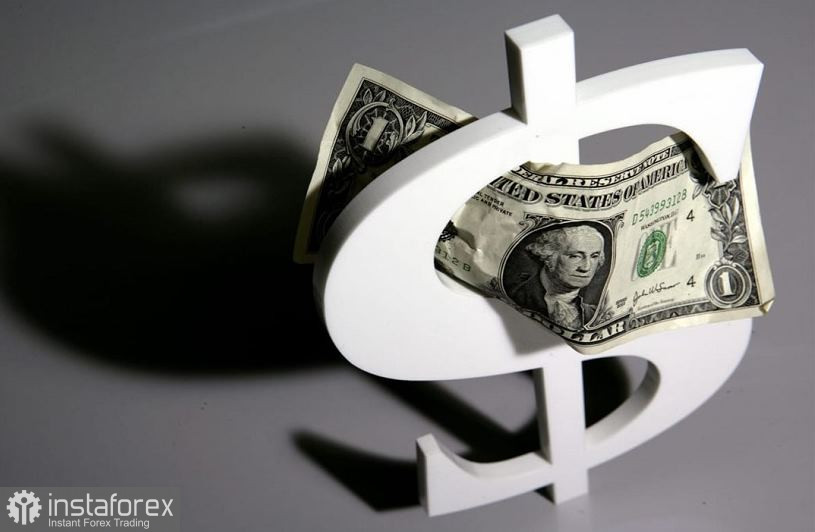The euro-dollar pair tested the seventh figure again at the start of the new trading week. The first attempt in the last two years was made last Thursday, but the EUR/USD bears failed to gain a foothold in this price area. However, under the prevailing conditions of a fundamental nature, the conquest of the seventh figure is only a matter of time.
It is noteworthy that traders are showing relatively high activity today, when many trading platforms of the world are closed as Catholics observe the Easter Monday. This indicates the strength of the downward trend, which is due not only to the strengthening of the dollar, but also to the weakening of the euro. The nearest target of the downward movement is 1.0750 (the lower line of the Bollinger Bands indicator on the daily chart). This target can be achieved in the very near future, given the current fundamental background for the pair.

The US dollar index reached 100.70 today – this is the maximum value of the indicator since March 2020, when the greenback was in high demand in the wake of the coronavirus crisis. Now several fundamental factors are playing in favor of the US currency at once. First of all, this is the divergence of the positions of the ECB and the Fed.
The results of the April meeting of the European Central Bank showed that the regulator is not ready for aggressive actions, despite the record increase in inflation in the eurozone. ECB President Christine Lagarde only announced the completion of the Asset Purchase Program (APP) in the third quarter of this year, after which the central bank will consider raising interest rates. However, the time gap between the end of QE and the rate hike is not fixed or somehow defined.
According to Lagarde, "several weeks or even months" may pass between these events. Given such an important remark, it can be concluded that even in conditions of unprecedented inflationary growth, the European regulator is not ready to implement the most hawkish scenario (two rounds of rate hikes – in June and in September-October).
Meanwhile, the US Federal Reserve is preparing for a 50-point rate hike at the May meeting. This decision is actually taken by the market in advance, as evidenced by the upward dynamics of the dollar index. Moreover, according to many experts, the Fed will decide on a 50-point increase in June. Further, at least until the end of this year, the US regulator will raise the rate by 25 basis points at each meeting. Also, the Federal Reserve will soon (most likely, in June) begin to reduce its balance sheet by 95 billion steps. This is quite a "sporty pace" when compared with previous similar cycles.
Such prospects strengthen the dollar throughout the market, and especially paired with the euro, which is forced to react not only to the ECB's passive position, but also to political factors. Note that the second round of presidential elections will be held in France next Sunday – April 24. Recent polls indicate the leadership of Emmanuel Macron, but Marine Le Pen's position is also quite strong (the ratio is 54% vs. 47%). The nervousness associated with these elections is also putting pressure on the euro.
And although Le Pen is no longer lobbying for the Frexit idea and the country's exit from the eurozone, she is still a Eurosceptic. In particular, she advocates the reform of the European Union – the transformation of the Alliance into a Union of Nations that will not be bound by common laws. Of course, such intentions cannot but alarm traders.
The EUR/USD pair is also under pressure from geopolitical factors. We are talking about the "Taiwan case" and the Russian-Ukrainian negotiations, which have clearly stalled.
Thus, the prevailing fundamental background contributes to the further decline of the EUR/USD pair. The dollar will continue to strengthen its position due to hawkish expectations and the growth of anti-risk sentiment, while the euro will continue to be under pressure from fundamental problems (ECB indecision, energy crisis, risks of stagflation, elections in France, lack of progress in Russian-Ukrainian negotiations).
From a technical point of view, EUR/USD is in a descending channel. The pair demonstrates a pronounced downward trend, which is confirmed by the Ichimoku indicator, which has formed its bearish signal on the daily chart. Also, the price on the higher timeframes (H4, D1, W1, MN) is located either on the lower or between the middle and lower lines of the Bollinger Bands indicator, which is in the extended channel. The support level (the target of the downward movement) is the lower line of the Bollinger Bands indicator on the daily chart, which corresponds to the price of 1.0750. In this price area, it would be advisable to lock in profits and take a wait-and-see position.
 English
English 
 Русский
Русский Bahasa Indonesia
Bahasa Indonesia Bahasa Malay
Bahasa Malay ไทย
ไทย Español
Español Deutsch
Deutsch Български
Български Français
Français Tiếng Việt
Tiếng Việt 中文
中文 বাংলা
বাংলা हिन्दी
हिन्दी Čeština
Čeština Українська
Українська Română
Română

